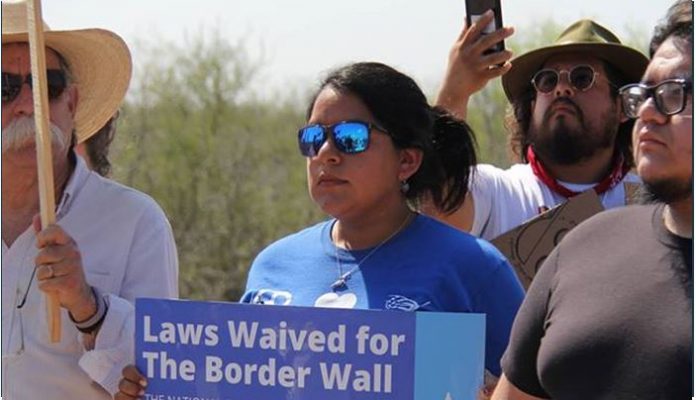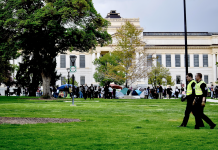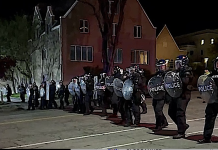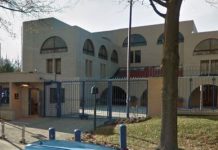
PHARR, Texas, Feb. 19 (UPI) — Members of a Native American group have camped out for a month in a South Texas cemetery to protect graves and a Methodist chapel from construction of a wall along the Mexico border.
“We are letting people know there are sacred sites here,” said Juan Mancias, chairman of the Carrizo Comecrudo tribe of South Texas.
About 10 protesters are camped at the Eli Jackson cemetery and the Jackson Ranch Methodist chapel and graveyard, both established in the 19th century.
“There are veterans buried here,” Mancias said. “We are trying to help some of our relatives who are ancestrally related to us by linear descent. The oldest one here was born in 1809 and died around the 1890s. You are looking at something that needs to be preserved. We have cleaned it up to show the graves are here.”
A sign honors American soldiers killed in the First and Second World Wars and the Korean War. U.S. flags sit on some of the gravestones. Their inscriptions indicate service in other wars, including Vietnam, and some tombstones date as far back as the Civil War.
The Carrizo Comecrudos’ ancestral lands extend for more than 600 miles from Brownsville, Texas, in the Gulf of Mexico to Pecos, Texas, and across both sides of the Rio Grande River.
U.S. Customs and Border Protection maps show that Hidalgo County will receive 25 miles of border wall, including the areas with the chapel and cemeteries. The agency did not return a request for comment about whether the border wall construction will affect the chapel and cemeteries.
But the sites are adjacent to the flood levee system. International treaties with Mexico prohibit U.S. Customs and Border Protection from erecting barriers in the floodplain of the Rio Grande. So the U.S. government instead has chosen to use the levees for the barriers, meaning that sections of the border wall will be 1 to 2 miles beyond the river — the actual international boundary with Mexico.
The cemeteries and chapel sit on the southern side of these levees. Not only would bollards put the chapel and cemeteries behind the wall, but the U.S. government also plans an illuminated 150-yard, clear-cut enforcement zone on each side of the levee. That means construction would destroy native Tamaulipan thornscrub forest and could affect the chapel and cemeteries.
“There’s no need for a wall,” Mancias said. “Border Patrol comes up here every 30 minutes to check on us. They drive on the levee. In a way, we are helping the agents. We are here to be aware of what is going on.
“The only criminal activity we are concerned with is the criminal activity from the president wanting to tear up a sacred site, especially a cemetery.”
Christopher Basaldú, a member of the tribe, has been camping in the Jackson cemetery for the past month.
A native of the Rio Grande Valley, Basaldú grew up in Brownsville and Corpus Christi, Texas, and holds a doctorate in anthropology from the University of Arizona, where he focused on Native American religion. He opposes construction of a wall on the border.
“I want to stand up against this kind of injustice on Carrizo Comecrudo territory, our original homelands,” Basaldú said, pointing out that the Spanish who invaded the Americas imposed the name on the group.
“This is like a double genocide. It is one thing to kill native people, but then to dig our ancestors out of the ground and exude them and disrespect their rest and erasing their literal memory in the ground, it’s genocide all over again,” Basaldú said.
He calls the border wall a racist project.
“There are native and indigenous peoples all along the national boundary, and these predate the invasion by Europeans,” Basaldú said. “These peoples need to be heard, and the government is not consulting them.”
Even though the government’s maps show all of Hidalgo County will be walled, U.S. Customs and Border Protection has not clarified its plans for land near the cemeteries and chapel. Camp protesters have seen government surveyors marking the levees, but the agency has not confirmed if it will build there.
“It is being deliberately vague and deliberately not doing due diligence and we have no commitment from the government that it won’t destroy the cemeteries and the chapel,” Basaldú said. “And the government’s letters of intent are only in English, not in Spanish.”
The cemetery’s history dates back to slavery. It was founded by descendants of Nathaniel Jackson, who was white, and his wife, Matilda Hicks, a freed slave. They left Alabama in the years before the Civil War. They came to Texas with a group of emancipated slaves, settling just north of the Rio Grande. The Jackson Ranch chapel was on the underground railroad, helping escaped slaves to freedom in Mexico, where slavery was outlawed.
“The chapel and cemeteries are a part of a history that some people don’t want to talk about and that is why we are here,” Mancias said.





